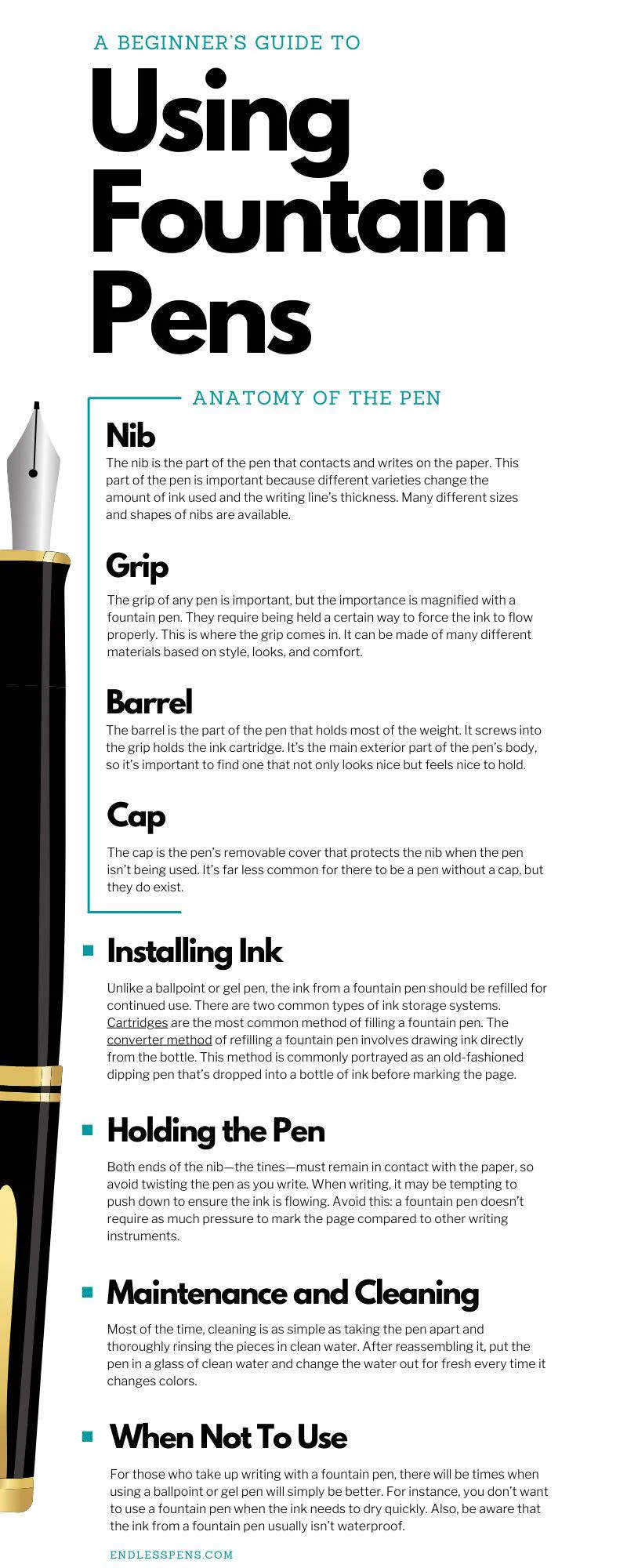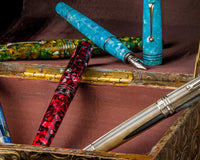The mystical fountain pen is seen by many as a writing utensil reserved exclusively for business executives and cranky old relatives. You don’t have to exclude yourself from an enjoyable writing experience simply because you don’t meet some imaginary salary requirements. Fountain pens offer a smooth writing experience and can take the place of ballpoint pens as your go-to tool for everything handwritten.
Many times, people are uncomfortable using anything new simply because they’re afraid of the unknown. In this beginner’s guide to using fountain pens, we’ll examine all the different features that make up this unusual writing utensil.
Anatomy of the Pen
Like most things manufactured today, a fountain pen is made up of several different sections. Each one is responsible for a different function and impacts the writing experience of the person using the fountain pen. Here is a closer look at the four segments that make a fountain pen when combined.
Nib
The nib is the part of the pen that contacts and writes on the paper. This part of the pen is important because different varieties change the amount of ink used and the writing line’s thickness. Many different sizes and shapes of nibs are available.
The unique thing about fountain pens is that the nib can be replaced or changed. Changing the nib allows the same pen to write with many different line sizes, ranging from extra-fine at 0.5 mm up to extra broad at 1.1 mm.
Grip
The grip of any pen is important, but the importance is magnified with a fountain pen. They require being held a certain way to force the ink to flow properly. This is where the grip comes in. It can be made of many different materials based on style, looks, and comfort.
Barrel
The barrel is the part of the pen that holds most of the weight. It screws into the grip holds the ink cartridge. It’s the main exterior part of the pen’s body, so it’s important to find one that not only looks nice but feels nice to hold. This is where your preferences take over—there’s a near-limitless combination of materials, colors, and styles the barrel can be made up of.
Cap
The cap is the pen’s removable cover that protects the nib when the pen isn’t being used. Sometimes referred to as the lid, the majority of fountain pens are designed to be used with the cap attached to the barrel to help with the weight and balance of the pen. It’s far less common for there to be a pen without a cap, but they do exist.
Installing Ink
One of the biggest hurdles facing many new fountain pen owners is how to install the ink. Unlike a ballpoint or gel pen, the ink from a fountain pen should be refilled for continued use. There are two common types of ink storage systems.
Cartridges
Cartridges are the most common method of filling a fountain pen. They’re the perfect option for beginners due to how simple they are to install. However, once a cartridge has been opened it can’t be resealed, so changing colors isn’t very practical with this method. It can also take some time for the ink to reach the nib.
Converters
The converter method of refilling a fountain pen involves drawing ink directly from the bottle. This method is commonly portrayed as an old-fashioned dipping pen that’s dropped into a bottle of ink before marking the page. This method of refilling the ink is almost always less expensive, but it does require more experience to successfully complete.
Holding the Pen
The way you hold a fountain pen differs from other writing utensils. You start by placing the nib at a 45-degree angle from the paper. Both ends of the nib—the tines—must remain in contact with the paper, so avoid twisting the pen as you write. When writing, it may be tempting to push down to ensure the ink is flowing. Avoid this: a fountain pen doesn’t require as much pressure to mark the page compared to other writing instruments. You must also avoid pressing too hard on the page because this can ruin the nib.
Maintenance and Cleaning
It’s important to include in the beginner’s guide to using fountain pens that they must be cleaned regularly by disassembling the unit and washing the parts. This includes removing dust particles and other debris that can clog the pen. Most of the time, cleaning is as simple as taking the pen apart and thoroughly rinsing the pieces in clean water. After reassembling it, put the pen in a glass of clean water and change the water out for fresh every time it changes colors. You should also periodically replace the converter if you use one to keep your pen in pristine writing condition.
When Not To Use
At the end of the day, a pen is a tool like any other: there are times when it should be used and times when it should be put away. For those who take up writing with a fountain pen, there will be times when using a ballpoint or gel pen will simply be better. For instance, you don’t want to use a fountain pen when the ink needs to dry quickly. Also, be aware that the ink from a fountain pen usually isn’t waterproof. You should take certain precautions when flying with a fountain pen, including not opening it until the airplane reaches cruising altitude.
If you’re ready to make the leap into the world of classy writing equipment and kiss those disposable pens goodbye, come explore the writing possibilities at Endless Pens. We have a huge selection of the finest ballpoint, rollerball, and fountain pens for sale with all the accessories to go with them.

By Some Folks at EndlessPens








1 comment
John Flynn
OK, but as a new user, how, specifly do I load a cartridge of ink into my new pen.